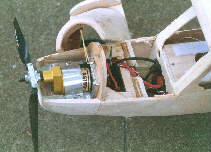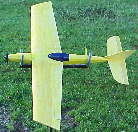 |
Flying High With Electric Power!
The Ampeer ON-LINE!
Fly the Future - Fly Electric! |
Site Table of Contents
| President: | Vice-President: | Secretary/Treasurer: |
| Ken Myers | Richard Utkan | Debbie McNeely |
| 1911 Bradshaw Ct. | 240 Cabinet | 4733 Crows Nest Ct. |
| Walled Lake, MI 48390 | Milford, MI 48381 | Brighton, MI 48116 |
| (248) 669-8124 | (248) 685-1705 | 810.220.2297 |
 | ||
| Board of Directors: | Board of Directors: | Ampeer Editor |
| Jim McNeely | Jeff Hauser | Ken Myers |
| 4733 Crows Nest Ct. | 18200 Rosetta | 1911 Bradshaw Ct. |
| Brighton, MI 48116 | Eastpointe, MI 48021 | Walled Lake, MI 48390 |
| (810) 220-2297 | (810) 772-2499 | (248) 669-8124 |
| Mailed Ampeer subscriptions are $10 a year US & Canada and $17 a year world wide. FREE on-line! | ||
| The Next Meeting: Date: Thursday, Nov. 7 Place: Ken's house: 1911 Bradshaw Ct., Walled Lake, MI Time: 7:30 p.m. | ||
|
From: David Byrd s.byrd@insightbb.com Hi, I am new to electric flight, and I have a problem. I have a VQ Macchi mc.205 ARF that I am in the process of converting to e-power. My problem is that my airframe, plane and retracts, weighs 63 ounces. My AF 625G and 16 Sanyo 2400 cells weigh 45.5 ounces. My radio gear including servos, retract servo, receiver, receiver battery and ESC weigh 14 ounces. That all comes to 122.5 ounces or 7.66 lbs. There is no info with the kit on wing area. I am guessing about 530 square inches. The plane is basically an Italian p-40. It has a 62 inch wing span. Is this too heavy? The short answer is yes. For many fliers, this wing loading will be uncomfortable to fly. You say that you figured approximately 530 sq.in. I went on the Internet and figured, based on the real plane and the wing span dimension, about 580 sq.in., if it is anywhere near to scale. At 530 sq.in. the wing loading would be, for me for this size plane, an uncomfortable 33.28 oz./sq.ft. If it is closer to 580 sq.in., then the wing loading would be 30.4 oz./sq.ft. How are you to get your airframe lighter than the motor and battery? In this instance, you’re not going to be able to get it lighter. You are working with a pretty much "fixed" entity when you are working with an ARF. I have an AF40g as well, but that means more cells. Going to the AF40G is not the answer in this case. While it will add more potential power, it will add more weight. This plane doesn’t need any more weight! I have figured that at this weight it will need about 75-80 watts per pound, if my info is right. Nothing wrong with trying for that range for a fighter type aircraft. Please give me more info and some insight. I am really excited about having an electric Warbird. While I personally would not try to convert this airframe to electric power, I would recommend that if you really, really want to do it, you should go brushless. You will need a motor, that on 16 cells, pulls about 35 amps static turning a prop no smaller than 13x9. I recommend that you give Tom Cimato a call at MaxCim (1-716-662-5651) or email him at maxcim_motors@localnet.com and give him this information. You could also call Aveox (818.597.8915) or drop them an email to neworders@aveox.com with the information. I am not real familiar on how to figure wing loading and how to figure wing area with only the dimensions I can get with a measuring tape. Wing loading equals the total weight divided by the sq.ft. of the wing
area. Square feet of the wing area equals square inches divided by 144. For your example of 122.5 oz. and 530 sq.in.
of wing area: 530 / 144 = 3.68 sq.ft. 122.5 / 3.68 = 33.29 oz./sq.ft.

Half the wing is shown in the diagram. The top triangle is 1.5 * 30, the rectangle is 6 * 30 and the bottom triangle is 1 * 30. Half the wing area is 255 sq.in. 255 * 2 = 510 sq.in. of wing area. How is it that everyone says the airframe has to weigh less than the motor and battery, yet, about every plane that is a .40 size or larger model, the airframe is heavier? On the electric website where I found your address, Keith Shaw’s 81" span Bearcat is said to weigh 15 lbs. From the motor he is using and battery pack, together they can only weigh about 4 1/2 pounds? So what gives? How does this formula work? I’m not sure that everyone says that, but for really good flying electric
planes, that is usually the case. To fly a heavier airframe requires more power. If you look at the data for Keith’s
Bearcat (http://members.aol.com/kmyersefo/page37.htm), you’ll notice that he is using a FAI 60. This allows more power
for take off and vertical. More power means a higher amp draw. The FAI 60 can handle quite large amp draws. It is a
trade off of flight time verses performance. Since Keith uses the throttle very well, his flight times are acceptable for this
big model.
More Planes from Walt Thyng
Hi Ken, The CommodorE a 1938 Ben Shereshaw design redone in 1978 for R/C. Wing span is approximately 80", weight 6 lbs. with 16 2000 NiCads, Astro 25G, FX 35D ESC (still working great!), SonicTronics 13x7 folder (the yellow prop goes great with the green fuse). covering some ancient Solarfilm from a shop I bought out. Transparent orange and semi-transparent Metallic green. Absolutely gorgeous on a sunny day! Very rapid climb on this power system. Will loop, and stall turn, rolls require a stout constitution and a LOT of altitude. This bird's forte is leisurely gliding flight, touch and goes, chandelles and low slow fly-bys. Pull-pull control system. 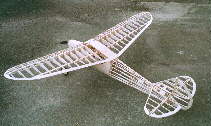
It uses a simple hatch system, note pin in firewall. motor mounting and battery access. 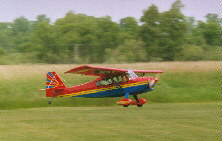 I think you showed my 1/4 scale Nosen Citabria in a Decathlon color scheme once before. Here's proof it flies. Astro 60G, 32 cells 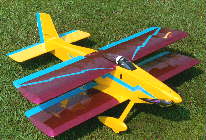 The Hot Kanary is a Top flight model that I planned to build just before I left the
hobby in the 80's. I built it from original plans. The weight 4.5 lbs. with 12 CP-1700s, Aveox 1010/2Y with Planeta 4.4:1
gearbox, L160 ESC, APCe 12x8 prop, wing span 40" and approximately 650 sq.in. Modifications include adding lower wing
ailerons and increasing all surfaces by 25%. Takeoffs are a little squirrelly and require a surprising distance (well over 100 ft. on
grass). Landings are easy, but require planning as the glide ratio is somewhat rock-like. Flying is a joy. Loops of whatever size
you want inside or outside, crisp rolls in both directions, knife-edge and four pointers solid, inverted flight requires almost no down
elevator. So far I haven't got it to spin. A fun plane! It is a BITSA built entirely from my parts and scrap bins. Monocote
covering.
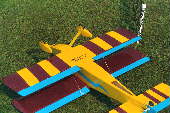 On the Four Star 40
Hi Ken, Here are a couple of photos of my Four Star 40 - though clubmates occasionally refer
to it as the "5*16", after its latest round of alterations. She's on her fourth motor - MaxCim 13Y & 13D, Astro
25G and Hacker B50 13S / 5.2:1 gearbox, and is slated to test fly the same Hacker on 6.7:1 sometime later this year. Cell counts
flown are 14, 16 & 20.
From the sharp end:
When first built, equipped with 20 cells and covered in Micafilm, she weighed just
over 6 lb. RTF. She is now at 5.75 lb. on 16 cells, due to repairs, alterations, and recovering in Monokote. Whereas most Four
Star 40s are built with considerable wood replacement, this one came pretty much out of the kit box. I replaced the Liteply aft
fuselage bottom sheet with balsa stick cross members though, and cut down the fuselage doublers considerably though. The wing
is pretty much 'stock' framework, bar the wing mounted servos. These are mounted inside the wing - I have this "thing"
about controls being inside. Go to a modern airfield and see how many aircraft have control elements on the outside!
Yours in modelling
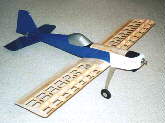
That Club Plane
Hi Ken, It has been a while since I have written to you. But have been reading your stuff
every month.
I thought you might be interested in our clubs wee project.
TCP-"That Club Plane"
All the best,
Gee Bee
Ken, A couple years ago I started a Gee Bee from Cris C.'s plans on your website. I think I sent you a link at the time with pictures of the almost completed, test flown model. The model is now completed with new scale covering and trim and wheel pants. It flies great on a geared Astro 020 brushless with 8 ea. 600 AE cells and a 10x6 APC electric prop. I said it flies great, but I do have a problem landing as it always noses over. A few static and in flight pictures are in my Ezone gallery and I have more. Thanks again
Electric Bipe
Ken: Thanks for your prompt responses for my requests for Ampeer back editions. I
have attached some pictures of my 13 oz. electric bipe, which I have recently started to fly. It was originally a gas job designed
and built back in the 1970's by one of our deceased club members. He specialized in 1/2 A gas designs or smaller. This design
was originally flown with a Cox .02 but not much, as it still like new.
New Version of Profili
I send you this message to inform you that a new major version of Profili, 2.0, has been released. Here are some of the new features:
Visit the new web site of Profili http://utenti.lycos.it/profili2 where you can obtain more info and download your version or order a CD-ROM. Best regards,
Stefano Duranti
Ciao Ken
Hi Ken. If you remember, I’m from Bologna, Italy. Congratulation for your review.
Great Advice
Hi Ken, I took your advice in regard to the 480 size motor.
Happy Landings
Tom Hunt’s New T3D
Hi Ken, I have e-mailed you be before. I am a member of SEFLI, and worked the NEAT fair the last couple of years. I wanted you to know that Tom Hunt recently designed an E3D plane (called the T3D). He produced a small number of "short" kits. This plane is beautiful! It goes together quickly and produces an excellent plane. (Small geared aveox on 10, 1300's) makes it affordable, easy to transport and an above average flyer! I am at work and forget the exact dimensions. ANYway if you like Larry's planes, you'll flip when you see this one! Cutting Tools
Hi Ken, I have been reading the Ampeer for many years now. It's great, keep up the good
work, and I'm sure it is work.
Regards,
Upcoming 36th Annual SOAR for FUN The 36th Annual SOAR for FUN will be held on scenic Mount Knobbly in West
Virginia near Cumberland, MD on 2-3 Nov 2002. It will be two fun-filled days of camaraderie and scenery that only
mountain-top soaring in the Autumn can bring you! (weather permitting!) All are welcome, AMA required for pilots.
UNI-DOME FLYING SCHEDULE
Hello indoor flyers of all sorts, The University of Northern Iowa in Cedar Falls and Bob's R/C Hobby Store have
reached an agreement to use the Uni-Dome covered football stadium for indoor flying this season. We will have an open fly-in
on Sunday, Dec.1, 2002, from 11a m to 5 pm. Then on the weekend of March 1 & 2, 2003 we will have a 2 day event starting at
6 pm Saturday evening until 11 pm, and Sunday from 7am to 4pm.
Bob Nelson
RX Problem Solved
Hi Ken, (A while back Bob was having trouble with this receiver and posted a question about it in the Ampeer. This is a follow-up. In the October issue, Bob noted replacing the receiver helped, but he then followed up with this. KM) Thought I would let you know I finally solved the interference problem I was having with the FMA Quantum RX. I recently read and article, I think the author was Bob Boucher (probably Bob Kopski KM), he suggested cutting an aileron extension cable and placing a 10 Micro Henry choke in each lead between the receiver and ESC. I gave it a try and it solved my problem. I have since flown the Rx with both a Kraft and JR transmitter. (Chokes are very useful with long extensions. Check out some of Bob Kopski’s columns on them in past issues of Model Aviation. KM) Robbe Starmax 40 Question
Hi Ken, I received the attached e-mail from Stephano Duranti in Italy informing me of his
updated Profili program. (Same email I received. KM) You may not have this info already so I thought you might like to
check it out. I reckon it will be a real competitor to Compufoil and it's still free. (With a pay more features available in the
pay for version. KM)
Oakland Yard Winter Flying
It may be cold outside, but in the dome the weather is always perfect for flying. For
our fourth season, Oakland Yard Athletics director David Dobrin will be running our Model Aviation Club on Saturday nights. All
participants will use our 72,000 square foot dome. Both radio control and free flight models are permitted as long as the model is
not powered by anything combustible. Our members fly a wide variety of planes ranging from delicate rubber powered free flight
airplanes that weigh less than a penny to radio controlled full combat airplanes.
Returning Membership: $130 Includes all 11 Saturday nights, 3rd annual 'Reindeer Fun Fly' and a member sweat shirt. New Members: $150 Includes all 11 Saturday nights, 3rd annual 'Reindeer Fun Fly' and a member sweat shirt. Individual Nights: $15 Saturday, November 2nd - 9:00 pm to 1:00 am Saturday, November 16th - 9:00 pm to 1:00 am Saturday, December 7th - 9:00 pm to 1:00 am Thursday, December 27th - 6:00 pm to 11:00 pm - 'Reindeer Fun Fly III' Saturday, January 11th - 9:00 pm to 1:00 am Saturday, January 25th - 9:00 pm to 1:00 am Saturday, February 8th - 9:00 pm to 1:00 am Saturday, February 22nd - 9:00 pm to 1:00 am Saturday, March 8th - 9:00 pm to 1:00 am Saturday, March 22nd - 9:00 pm to 1:00 am Saturday, April 5th - 9:00 pm to 1:00 am Saturday, April 19th - 9:00 pm to 1:00 am Thursday, December 27 Bring out your new holiday toys for their first flight! Aviation Director, David Dobrin, will organize the festivities with the ‘free flight’ models from 6:00 to 8:00 pm. From 8:00 to 11:00 pm, the electric R/C planes will take to the sky. The first 40 children will receive their own hand-launched glider to build, fly and keep. The kids' flying time will run from 7:00 to 8:00 p.m. After the 'free flight' portion of the evening, children are welcome to stay to watch the radio control planes. As featured last year, the R/C Zagi's will be dog fighting around 9:00 p.m. Children ‘free flight’(Limited to the 1st 40 kids) $5 7:00-8:00 p.m. Adult ‘free flight’ $10 6:00-8:00 p.m. Adult ‘R/C’ $15 8:00-11:00 p.m. You can contact Dave Dobrin at david@oaklandyard.com or
5328 Highland Road Waterford, MI 48327 248-673-0100 fax: 248-673-1084 Charger Question
Ken, I am somewhat new to Electric flight. I have flown glow planes for about two
years and guys around here were very biased to glow planes. EP was put down a lot and surely not promoted. I stumbled my
way into EP planes while looking for something to train my 12 year old son on that could be flown in a park etc. Somehow I
ended up buying a GP Spectra electric sailplane. My son is still more interested in computer games but I fell in love with the
Spectra!!! I have sold all of my old glow planes and equipment so I can buy more EP planes! Quiet, clean and convenient
makes it perfect for me.
1. Graupner Ultra Duo 30 (somewhat new and I believe made by Schulze)
The Ginzel is not available because of parts shortage so I guess it's out. The new
Graupner Duo 30 looks very nice. It has a 2nd port for up to 8 cells which would be great for xmtr packs. The Schulze 6-330
and Orbit v6.0 also look very good. These two have a PC interface and software that I don't think the new Graupner has.
I responded to Kent that all of the chargers that he mentioned are good ones. It is really up to him to determine which one has the features that he wants and would most likely use. I also told him that if I had a need to purchase a new charger right now, I’d get the Astro Flight 110Deluxe. I really love this charger because it is totally a KISS product. Doug had the prototype at the Mid-Am. Keith is now using one. It is simple and easy to use. For me, the most important thing is that it can now charge at up to 8 amps. Specs from the Astro Flight site are:
To Reach Ken Myers, you can land mail to the address at the top of the page. My E-mail
address is:
KMyersEFO@aol.com
|

